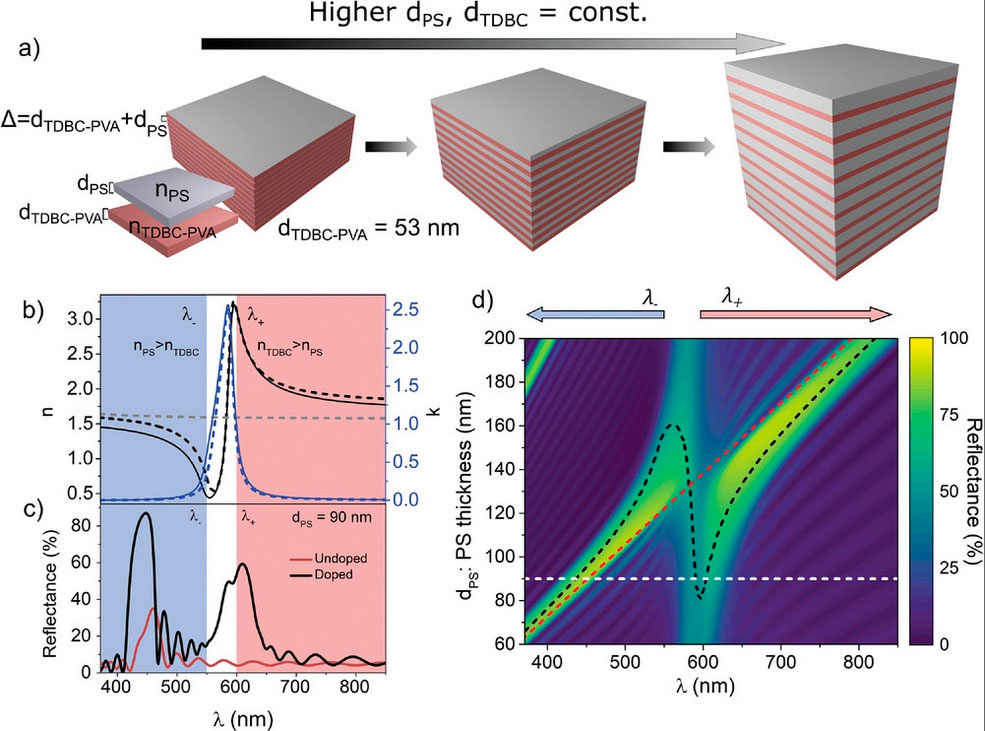Enhanced Light Absorption in All-Polymer Biomimetic Photonic Structures by Near-Zero-Index Organic Matter

Do you know what slow light is?
Emulating the complex photonic structures of some plants to achieve enhanced light absorption.
It has recently been discovered that the chloroplasts of some shade plants show iridescence due to structures that have been given the name of iridoplasts. These iridoplasts have a photonic crystal structure formed from a periodic arrangement of the light-absorbing thylakoid tissue itself. This structure enhances photosynthesis thanks to sophisticated light-matter interactions, which allow for greater absorption of available light thanks to the phenomenon known as slow-light.
Beyond the fundamental biological aspects, these natural nanostructures are very attractive as models to design advanced photonic devices. However, soft matter biomimetic construction of such nanostructures is challenging due to the low refractive index contrast of most organic photonic structures (photonic devices are typically fabricated using materials with very different refractive indices, and thus with high contrast). One strategy to solve this problem is to use excitonic organic materials with near-zero refractive index (NZI) optical properties.
The studio
In this work, it is shown how multilayer structures formed by excitonic materials that mimic natural photonic structures (biomimetics) are capable of giving rise to a strong reflectance that is tunable in a large bandwidth, and also allows an improvement in the absorption of light. light through the phenomenon of “slow light”. These results open a new route towards the development of active devices based on photonic structures of almost zero-index polymeric materials.
The organic excitonic materials used in this work are called J aggregates. They are dyes that at high levels of aggregation present very narrow absorption and emission bands that, as shown in this work, correspond to refractive indices close to zero. , in which the properties of light change drastically.

How can a material have a refractive index less than 1?
The refractive index (n) of a material medium is defined as the ratio between the speed of light in a vacuum (c) and its propagation speed in the medium (v), n=c/v. According to this, only if v is greater than c the index can be less than 1. But, according to the theory of relativity, no information can travel faster than the speed of light in a vacuum, but this does not mean that the index of refraction cannot be less than 1.
Actually the speed we refer to in the refractive index is the phase speed of light. The phase speed is the speed at which the wave crests are moving and can be faster than the speed of light in a vacuum and thus result in a refractive index less than 1.
If a change in intensity is applied to the light, turning it on or off for example, this change will be transmitted at the group speed, which will not be greater than the speed of light, even if the refractive index is less than 1.
An example of a plasma with a refractive index less than unity is the Earth’s ionosphere. Since the ionosphere’s index of refraction is less than unity, electromagnetic waves propagating through the plasma are bent “downward,” allowing the radio wave to refract back toward Earth.
Slow light
As we have said, the relationship between the speed of light in a vacuum and the speed of the phase is called the refractive index (n). The refractive index is not a constant for a given material, but rather depends on temperature, pressure, and very importantly, on the frequency (or wavelength) of the incoming light wave.
People perceive the intensity of the light wave as brightness and the frequency as color. If a light is switched on or off at a specific time, then the change in amplitude of the wave does not propagate at the phase speed but, as we have already said, at the group speed. The speed of the group depends not only on the refractive index of the material, but also on the way in which the refractive index varies with frequency (that is, the derivative of the refractive index with respect to frequency).
Slow light refers to a very low group light speed. If the refractive index is such that it changes rapidly for a small range of frequencies, then the group velocity could be very low, thousands or millions of times less than c, regardless of the refractive index of the material.
More details of the study
In this work, it is proposed and experimentally demonstrated that iridoplasts can function as a model for the development of photonic structures in which near-zero refractive index properties are enhanced by multilayers designed to tailor absorption to wavelengths far below. below the absorption maximum. This has been achieved by doping the polymer layers with J-aggregates and forming a Bragg grating similar to the photosynthetic pigment distribution in natural iridoplasts.
The scientific team has shown that the combination of the near-zero refractive index properties of J-aggregate layers with biomimetic photonic structuring enables enhanced absorption at certain wavelengths outside of the J-aggregate resonance. These wavelengths they can be selected by suitably designing the multilayer periodicity, which allows their tunability. Remarkably, this is the first fully polymeric structure fabricated to demonstrate the enhancement of slow light absorption induced by near-zero index organic materials. The fact that this structure is completely organic brings material advantages such as low manufacturing cost and low environmental impact and paves the way for the use of near-zero refractive index organic materials in various fields.
This is a research work developed by the Group of Natural and Artificial Photonic Structures of the International Iberian Nanotechnology Laboratory of Portugal (INL), and the CINBIO of the University of Vigo, with the collaboration of the Faculty of Physics of the University of Santiago de Compostela, the Department of Physics and Astronomy of the University of Exeter, and the Laser Processing Group of the Institute of Optics (CSIC)




